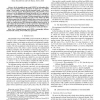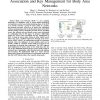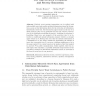121 search results - page 11 / 25 » Identity-based key agreement protocols from pairings |
TIT
2008
13 years 6 months ago
2008
Abstract--In the bounded-storage model (BSM) for information-theoretic secure encryption and key agreement, one makes use of a random string R whose length t is greater than the as...
INFOCOM
2010
IEEE
13 years 4 months ago
2010
IEEE
Body Area Networks (BAN) is a key enabling technology in E-healthcare such as remote health monitoring. An important security issue during bootstrap phase of the BAN is to securely...
EUROCRYPT
2003
Springer
14 years 17 days ago
2003
Springer
Perfectly secret message transmission can be realized with only partially secret and weakly correlated information shared by the parties as soon as this information allows for the ...
STOC
2009
ACM
14 years 8 months ago
2009
ACM
We study the question of basing symmetric key cryptography on weak secrets. In this setting, Alice and Bob share an n-bit secret W, which might not be uniformly random, but the ad...
24
Voted
ASIACRYPT
2008
Springer
13 years 9 months ago
2008
Springer
We study the security of the widely deployed Secure Session Layer/Transport Layer Security (TLS) key agreement protocol. Our analysis identifies, justifies, and exploits the modul...



